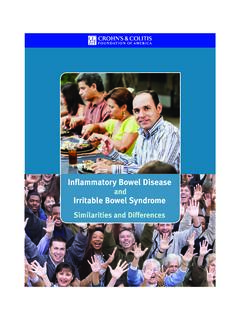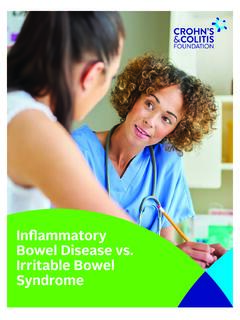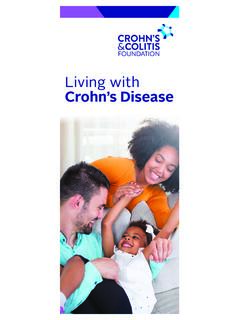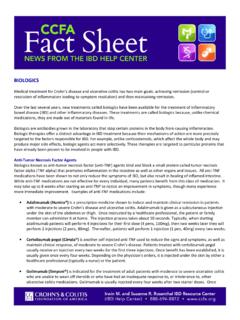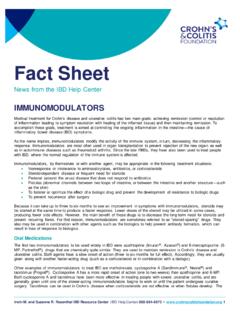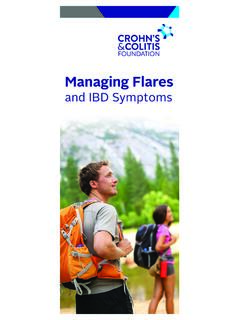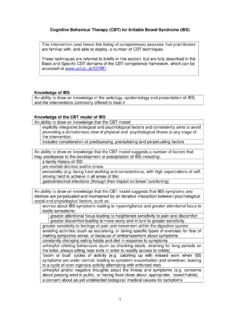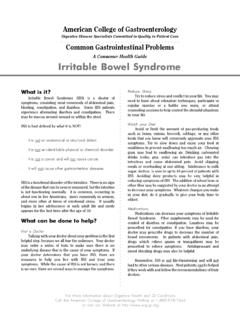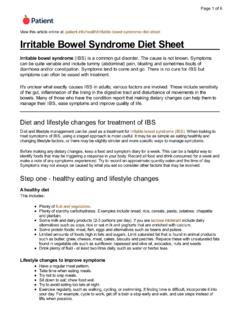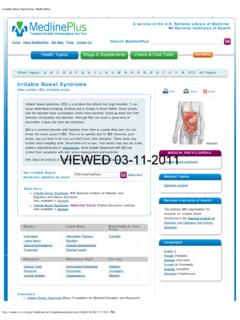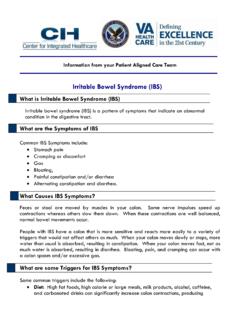Transcription of Inflammatory Bowel Disease - Crohn's | Colitis | IBD
1 Inflammatory Bowel Disease and irritable Bowel syndrome Similarities and Differences 2 IBD Help Center: Important Differences Between IBD and IBS. Many diseases and conditions can affect the gastrointestinal (GI) tract, which is part of the digestive system and includes the esophagus, stomach, small intestine and large intestine. These diseases and conditions include Inflammatory Bowel Disease (IBD) and irritable Bowel syndrome (IBS). IBD Help Center: 3. Inflammatory Bowel diseases are a group of Inflammatory conditions in which the body's own immune system attacks parts of the digestive system.
2 Inflammatory Bowel Disease Inflammatory Bowel diseases are a group of inflamma- Causes tory conditions in which the body's own immune system attacks parts of the digestive system. The two most com- The exact cause of IBD remains unknown. Researchers mon Inflammatory Bowel diseases are Crohn's Disease believe that a combination of four factors lead to IBD: a (CD) and ulcerative Colitis (UC). IBD affects as many as genetic component, an environmental trigger, an imbal- million Americans, most of whom are diagnosed before ance of intestinal bacteria and an inappropriate reaction age 35.
3 There is no cure for IBD but there are treatments to from the immune system. Immune cells normally protect reduce and control the symptoms of the Disease . the body from infection, but in people with IBD, the immune system mistakes harmless substances in the CD and UC cause chronic inflammation of the GI tract. CD intestine for foreign substances and launches an attack, can affect any part of the GI tract, but frequently affects the resulting in inflammation. end of the small intestine and the beginning of the large intestine. The inflammation in CD can affect all layers of the intestinal lining.
4 Ulcerative Colitis (UC) is characterized by Who Gets IBD? inflammation in the large intestine (colon) and the rectum. As many as 60,000 new cases of IBD are diagnosed in the The inflammation in UC occurs only in the innermost layer United States each year. of the intestinal lining. Age. IBD can occur at any age, but often people are diagnosed between the ages of 15 and 35. Symptoms The symptoms of IBD vary from person to person, and may Gender. In general, IBD affects men and women equally. change over time. The most common symptoms for CD and UC are frequent and/or urgent Bowel movements, diarrhea, Ethnicity.
5 IBD is more common among Caucasians, but it bloody stool, abdominal pain and cramping. can affect people of any racial or ethnic group. People with IBD may also report symptoms such as fatigue, Family history. As many as one in five people with IBD. lack of appetite and weight loss. IBD is characterized by have a first-degree relative (parent, child or sibling) with times of active Disease (flares), when symptoms are pres- the Disease . ent, and times of remission, when little or no symptoms are present. Cigarette smoking. Smokers are more likely to develop CD.
6 The Crohn's & Colitis Foundation of America provides information for educational purposes only. We encourage you to review this educational material with your health care professional. The foundation does not provide medical or other health care opinions or services. The inclusion of another organiza- tion's resource or referral to another organization does not represent an endorsement of a particular individual, group, company or product. 4 IBD Help Center: The exact cause of CD and UC remains unknown. Researchers believe that several factors, such as a family predisposition and a faulty immune system, play a role in their development.
7 Diagnostic Procedures Endoscopic procedures. This procedure utilizes a flexible tubular camera to look inside of the digestive tract by To help confirm a diagnosis of CD or UC, one or more of entering through the mouth or anus. The scope has the following tests and diagnostic procedures may be other tools that may be used for additional purposes, performed. including the collection of tissue samples or biopsies. Blood tests. The presence of inflammation in the body A. capsule endoscopy may also be performed. This can be identified by examining the levels of several involves swallowing a capsule equipped with a camera factors in the blood, including red and white blood cells, (PillCam , Endo Capsule ) that takes pictures as it travels platelets and C-reactive protein (CRP).
8 Through the intestine. The images are wirelessly sent to a receiver worn by the patient. The capsule is expelled T ests may be performed to help health care providers during a Bowel movement, usually within a day. differentiate IBD from non-IBD and CD from UC (ex., IBD. sgi Diagnostic). In certain situations, blood tests may External imaging procedures. These procedures utilize also be used to evaluate a patient's risk of developing different technologies to generate images of the diges- Disease complications, as well as to optimize treatment tive organs and other soft tissue from outside the body, strategies (ex.)
9 , Crohn's Prognostic test). including computerized tomography (CT) scans and magnetic resonance imaging (MRI). Stool tests. Stool tests look for signs of inflammation in the GI tract as well as infections. Complications Some people with IBD may experience complications, including deep ulcerations, Bowel obstructions, infec- tions and malnutrition. Patients with IBD are also at an increased risk of colon cancer. However, many people with IBD find that with proper treatment and lifestyle changes, they can live normal, fulfilling lives. To learn more about CD and UC, view: Living with Crohn's Disease at: Living with Ulcerative Colitis at: IBD Help Center: 5.
10 irritable Bowel syndrome is not a Disease , but rather a condition that affects the function and behavior of the intestines. irritable Bowel syndrome irritable Bowel syndrome is a condition that affects the Who Gets IBS? function and behavior of the intestines. Normally, the mus- cles lining the intestines intermittently contract and relax IBS affects an estimated 10 15% of adults in the United to move food along the digestive tract. In IBS, this pattern States. is disturbed, resulting in uncomfortable symptoms. More than 40 million people are affected by IBS.
